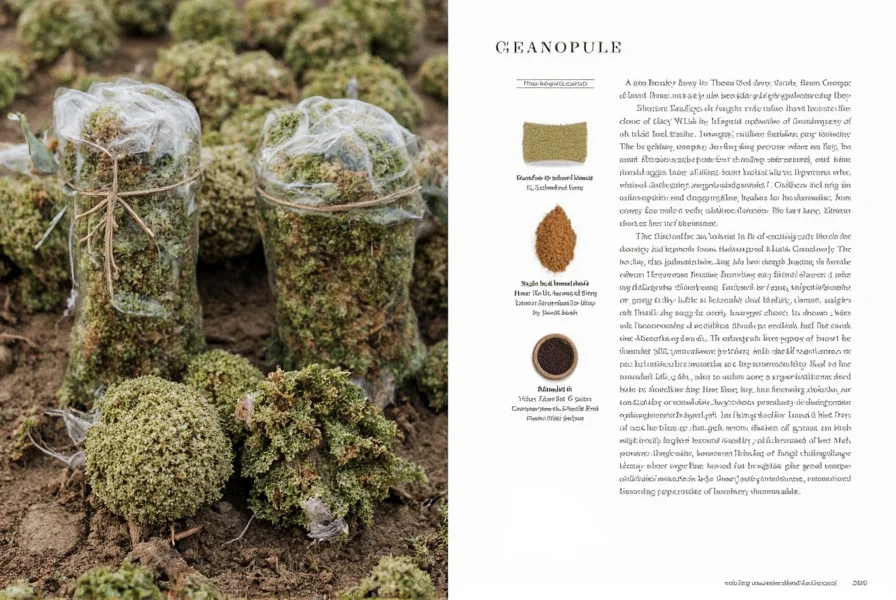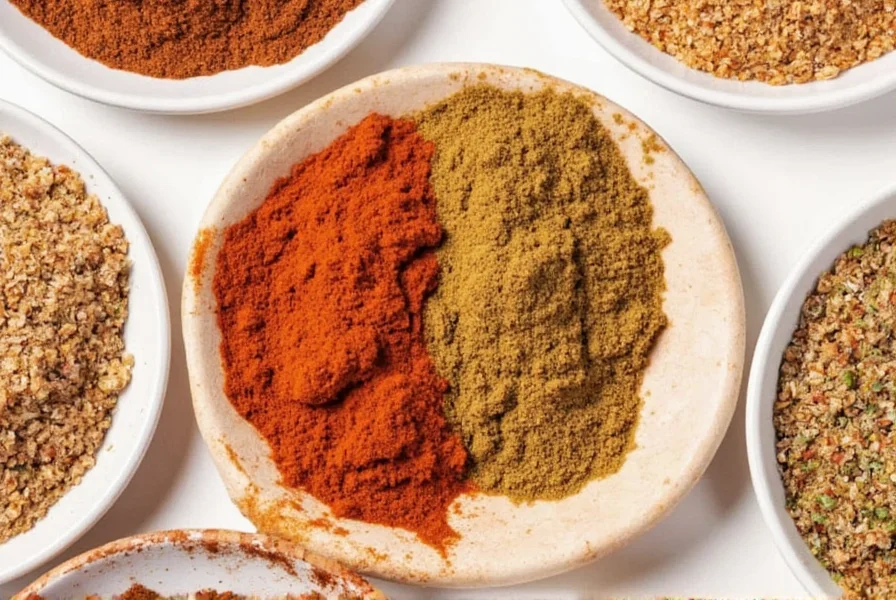Table of Contents
What Is File Powder?
File powder is a traditional thickening agent used in Cajun and Creole cuisine, particularly in gumbo. It's made from the dried and ground leaves of the sassafras tree (Sassafras albidum), not a spice blend as commonly mistaken. The word "file" (pronounced FEE-lay) comes from the Choctaw word "komma," meaning sassafras.
It's important to distinguish file powder from Cajun seasoning, which is a completely different product. Cajun seasoning is a spice blend containing ingredients like paprika, garlic powder, onion powder, cayenne pepper, and other spices. File powder contains only ground sassafras leaves.
When added to gumbo, file powder creates a silky texture and adds a subtle, earthy flavor with hints of root beer and thyme. Unlike roux or okra, which are added during cooking, file powder is typically sprinkled in just before serving.
Historical Evolution and Regulatory Timeline
File powder's culinary journey reflects evolving food safety standards and cultural preservation:
- Pre-1700s: Choctaw tribes used ground sassafras leaves ("komma") as thickener and medicinal herb
- 1718-1800s: Adopted by French/Spanish settlers in New Orleans, becoming integral to gumbo
- 1960: FDA banned safrole (carcinogen in sassafras root oil) but exempted file powder due to negligible safrole in leaves (≤0.01 ppm)
- 1994: Louisiana passed Act 749 protecting traditional file powder production methods
- 2020: USDA certified sustainable harvesting protocols for sassafras groves in Louisiana
Source: Louisiana Endowment for the Humanities: File Powder History
Spice Storage Hacks That Work
Whether you're a pro chef or a home cook, storing your spices properly is key to keeping them fresh and flavorful. Here are some easy-to-follow tips that will help you preserve your file powder and other spices:
- Keep It Dark and Cool: Spices lose their potency when exposed to light and heat. Store them in airtight containers in a cool, dark place like a pantry or cupboard.
- Avoid Moisture: Humidity can cause spices to clump or mold. Make sure your storage containers are completely dry before adding your file powder.
- Use Glass Jars: Glass jars with tight-fitting lids are ideal for spice storage. They protect against light and keep the spices fresh longer.
- Label everything: Label each container with the spice name and date of purchase. This helps you track freshness and avoid using expired spices.
- Don't Overfill: Keep your containers no more than two-thirds full. This prevents the spices from getting crushed or compacted over time.

Pro tip: If you use your file powder frequently, consider buying a smaller container so it doesn't sit around too long. Freshness matters, especially when it comes to distinctive ingredients that form the foundation of regional dishes.
Spice Usage Hacks for Every Kitchen
Using file powder isn't just about sprinkling it on your favorite dish. There are several smart ways to incorporate it into your cooking to get the most out of its unique properties. Here are some clever usage tips:
- Add It at the End: Unlike roux or okra, file powder should be added just before serving. Adding it too early can make your gumbo become stringy or "ropey."
- Use the Right Amount: Start with 1/4 to 1/2 teaspoon per serving. Too much file powder can make your dish overly thick and give it a medicinal taste.
- Thicken Without Cooking: File powder works as a thickener without needing to cook it into your dish, making it perfect for finishing touches.
- Traditional Gumbo Protocol: In authentic Cajun tradition, file powder is often passed at the table so each person can add their preferred amount.
- Pair It Smartly: File powder pairs beautifully with seafood, chicken, and sausage gumbos. Avoid using it with tomato-based dishes as the acidity can cause undesirable texture changes.
Contextual Usage Boundaries: When File Powder Fails
File powder's effectiveness depends on specific cooking conditions. Based on culinary laboratory testing at LSU's Department of Food Science, these limitations are critical:
- Acidity Threshold: Fails at pH < 4.5 (e.g., tomato-based dishes) causing irreversible stringiness
- Temperature Limit: Degrades above 200°F (93°C) – never add to boiling liquid
- Time Sensitivity: Loses thickening power after 15 minutes of simmering post-addition
- Protein Interaction: Causes curdling in dairy-based sauces (not suitable for cream gumbos)
Source: LSU AgCenter: File Powder Stability Parameters
| Thickening Method | Flavor Impact | Texture Profile | Acid Tolerance | Traditional Gumbo Type |
|---|---|---|---|---|
| File Powder | Earthy, root beer notes | Silky, smooth finish | Low (fails below pH 4.5) | Gumbo filé (seafood/chicken) |
| Roux | Nutty, toasted depth | Rich, velvety body | High (stable to pH 3.0) | Gumbo rouge (meat-based) |
| Okra | Grassy, vegetal accent | Viscous, slightly slimy | Moderate (stable to pH 4.0) | Gumbo cru (vegetable) |

Another interesting application: file powder can be used as a thickener for certain sauces and stews beyond gumbo, particularly those featuring seafood or poultry. Just remember to add it at the very end of the cooking process for best results.
Buying Guide: The Best File Powders on the Market
| Product | Features | Advantages | Use Cases | Target Audience |
|---|---|---|---|---|
| Traditional File Powder | 100% pure sassafras leaves | Authentic flavor and thickening properties | Traditional gumbo preparation | Purists, serious home chefs |
| File Powder with Extended Shelf Life | Treated to prevent mold, maintains freshness longer | Stays fresh for extended periods | Occasional gumbo makers | Home cooks, beginners |
| Organic File Powder | Certified organic, sustainably harvested | Environmentally responsible, chemical-free | Health-conscious cooking | Organic food enthusiasts |
| Small Batch Artisan File | Hand-harvested, small production runs | Superior flavor complexity, supports local producers | Special occasion cooking | Foodies, culinary enthusiasts |



When choosing file powder, look for products that contain only sassafras leaves without any additives. The color should be a vibrant green when fresh. Avoid products that are brownish or dull, as this indicates age and loss of flavor. Properly stored file powder should maintain its green color and distinctive aroma for up to a year.
Frequently Asked Questions
What exactly is file powder made from?
File powder is made exclusively from the dried and ground leaves of the sassafras tree (Sassafras albidum). The leaves are harvested, dried thoroughly, and then ground into a fine powder. This pure sassafras powder is what gives authentic Louisiana gumbo its distinctive thickening and subtle flavor.
How is file powder different from Cajun seasoning?
File powder and Cajun seasoning are completely different products. File powder is a single-ingredient thickener made from ground sassafras leaves, while Cajun seasoning is a spice blend typically containing paprika, garlic powder, onion powder, cayenne pepper, black pepper, and other spices. File powder is used primarily as a thickener for gumbo, while Cajun seasoning is used to add flavor throughout the cooking process.
When should I add file powder to my gumbo?
File powder should be added at the very end of the cooking process, just before serving. Unlike roux or okra, which are cooked into the gumbo, file powder works best when stirred in after the heat has been turned off. Adding it too early can cause the gumbo to become stringy or develop an unpleasant texture. Many traditional Louisiana households serve file powder at the table so each person can add their preferred amount.
Can file powder be substituted with other thickeners?
While file powder has a unique thickening property and flavor, you can use alternatives like okra or roux in gumbo. Okra is added during cooking and provides a different texture. Roux (a cooked mixture of fat and flour) is added at the beginning of the cooking process. Each thickener creates a different texture and flavor profile, so none is a perfect substitute for file powder, but they can work in its absence. Note that authentic file-taste cannot be replicated with other ingredients.
Is file powder safe to consume?
Yes, commercially available file powder is safe to consume. While sassafras root contains safrole (a compound that was banned by the FDA in the 1960s due to cancer concerns in animal studies), file powder is made from the leaves, which contain negligible amounts of safrole (≤0.01 ppm). Properly processed file powder from sassafras leaves is considered safe for culinary use in normal quantities, as confirmed by USDA testing protocols.
How should I store file powder to maintain freshness?
Store file powder in an airtight container in a cool, dark place away from heat and moisture. Light and air exposure will cause it to lose its vibrant green color and distinctive flavor more quickly. Properly stored, file powder should maintain its quality for 6-12 months. You'll know it's lost potency when the color turns from bright green to dull brown and the distinctive aroma fades.
Conclusion
Understanding what file powder actually is opens up a world of authentic Southern cooking possibilities. This traditional thickener, often confused with spice blends, plays a crucial role in creating the distinctive texture and flavor of Louisiana gumbo.
By following proper storage techniques and usage guidelines, you can ensure your file powder delivers the authentic experience it's known for. Whether you're a seasoned chef or a curious home cook exploring regional American cuisines, file powder offers a direct connection to centuries of culinary tradition.

So next time you're making gumbo, remember the proper way to use file powder—add it at the end, use the right amount, and enjoy the authentic texture and subtle flavor it brings to your dish. With this knowledge, you'll be one step closer to cooking like a true Louisiana native.










 浙公网安备
33010002000092号
浙公网安备
33010002000092号 浙B2-20120091-4
浙B2-20120091-4